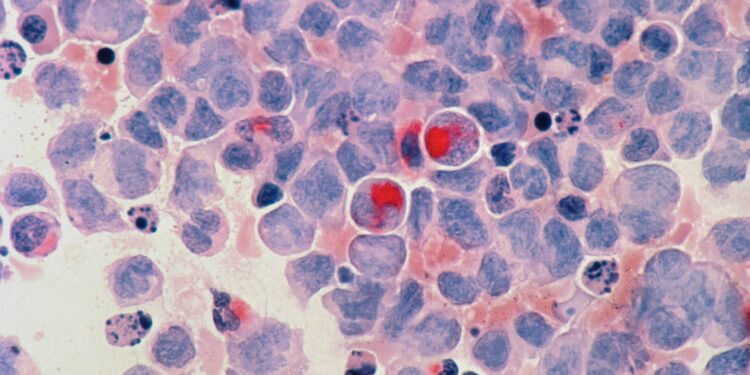Acute myeloid leukemia (AML). Credit: Unsplash/CC0 Public domain
An international team of scientists has discovered a mechanism by which acute myeloid leukemia (AML) cells maintain their growth.
Researchers from Baylor College of Medicine, the University of Veterinary Medicine in Austria, and the Josep Carreras Leukemia Research Institute in Spain have discovered that AML cells prevent the synthesis of proteins that stunt their growth by forcing the mRNAs that encode these proteins into structures called P-bodies. The findings, published in Natural Cell Biologyprovide a new perspective on the survival mechanisms of AML and the possibilities for new anticancer therapies.
“Despite significant advances in cancer research, the prognosis for most AML patients remains poor,” said study co-author Bruno Di Stefano, MD, assistant professor of molecular and cellular biology and member of Baylor’s Stem Cell and Regenerative Medicine (STaR) Center. “Our goal was to identify and mechanistically understand novel vulnerabilities in leukemia cells that could potentially be therapeutically targeted in AML.”
Previous studies have shown that leukemia cells corrupt the process of translating mRNA into proteins in ways that facilitate their growth, but the underlying mechanisms are poorly understood.
“Our first insight into how leukemia cells can disrupt normal translational control was the discovery that they harbored more P-bodies than their normal counterparts,” said Di Stefano, a member of the Dan L Duncan Comprehensive Cancer Center. “Interestingly, P-bodies were essential for the growth of leukemia cells but not normal blood cells, suggesting a potential AML-specific addiction.”
P-bodies are a type of biomolecular condensates that concentrate proteins and nucleic acids such as RNA inside cells. P-bodies serve as reservoirs that sequester specific mRNAs from the cellular machinery that translates them into proteins. “We think of P-bodies as storage units for RNAs,” Di Stefano said.
The researchers profiled mRNAs in the P-bodies of AML cells. “We found that leukemia cells sequester mRNAs encoding tumor suppressor proteins in the P-bodies,” Di Stefano said. “Importantly, these mRNAs were not degraded, and by forcibly dissolving the P-bodies, we found that the mRNAs could be translated into proteins that could reduce AML.”
“Indeed, abolishing P-bodies by deleting DDX6, one of the proteins responsible for their formation, triggered cancer cell death in various models of human AML, across several different subtypes and mutations,” said co-corresponding author Dr. José L. Sardina, principal investigator at the Josep Carreras Leukemia Research Institute.
“AML is a heterogeneous disease and the discovery of a molecular pathway that could be a conserved Achilles heel is very exciting. Similarly, loss of P-body had little effect on normal blood cell production, further highlighting the potential for targeting P-body formation in AML.”
“The discovery that AML cells depend on P-bodies and the underlying molecular mechanisms has several important implications,” said co-corresponding author Dr. Florian Grebien, professor of medical biochemistry at the University of Veterinary Medicine Vienna.
“First, this work provides new insights into the little-studied mechanism of controlled mRNA translation in the context of cancer development. Second, since DDX6 is a pharmacologically treatable molecule, our work opens new avenues for the development of anticancer agents targeting this mechanism.”
More information:
RNA sequestration in P bodies maintains myeloid leukemia, Natural Cell Biology (2024). DOI: 10.1038/s41556-024-01489-6
Provided by Baylor College of Medicine
Quote: P-bodies support acute myeloid leukemia cell growth: Survival mechanism offers opportunities for new therapies (2024, August 21) retrieved August 21, 2024 from
This document is subject to copyright. Apart from any fair dealing for the purpose of private study or research, no part may be reproduced without written permission. The content is provided for informational purposes only.



